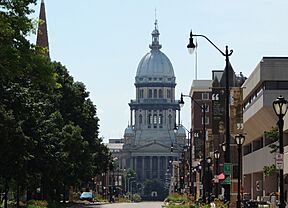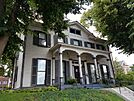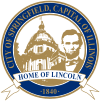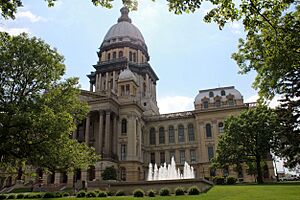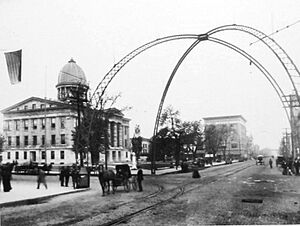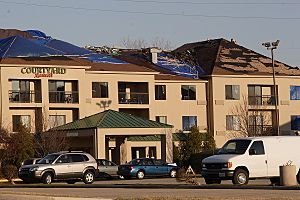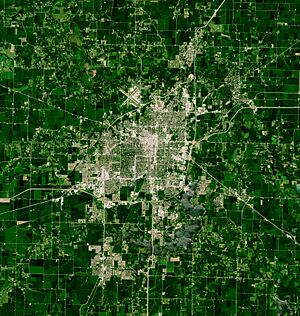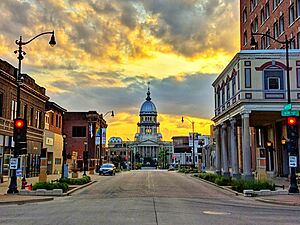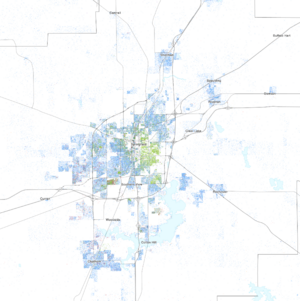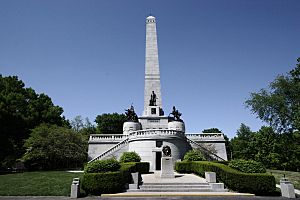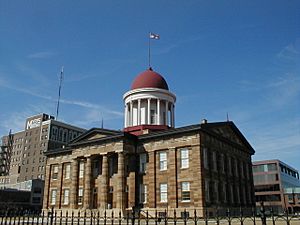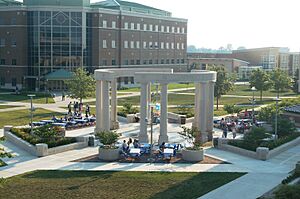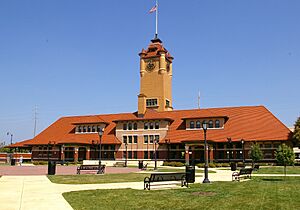Springfield, Illinois facts for kids
Quick facts for kids
Springfield, Illinois
|
|||
|---|---|---|---|
|
Downtown Springfield and the Illinois State Capitol
|
|||
|
|||
| Motto(s):
Home of President Abraham Lincoln
|
|||
| Country | United States | ||
| State | Illinois | ||
| County | Sangamon | ||
| Townships | Capital, Springfield, Woodside | ||
| Founded | April 10, 1821 | ||
| Incorporated Town | April 2, 1832 | ||
| City Charter | February 3, 1840 | ||
| Government | |||
| • Type | Mayor-Council | ||
| Area | |||
| • Total | 67.49 sq mi (174.79 km2) | ||
| • Land | 61.16 sq mi (158.41 km2) | ||
| • Water | 6.33 sq mi (16.38 km2) | ||
| Elevation | 600 ft (183 m) | ||
| Population
(2020)
|
|||
| • Total | 114,394 | ||
| • Density | 1,870.37/sq mi (722.16/km2) | ||
| Time zone | UTC−6 (CST) | ||
| • Summer (DST) | UTC−5 (CDT) | ||
| ZIP codes |
ZIP codes
|
||
| Area code | 217/447 | ||
| FIPS code | 17-167-11046 | ||
| GNIS feature ID | 2395940 | ||
Springfield is the capital city of Illinois, a state in the United States. It is also the main city of Sangamon County. In 2020, about 114,394 people lived there. This makes it the seventh largest city in Illinois. It is also the biggest city in Central Illinois. The Springfield area, including nearby counties, has about 208,000 residents.
Springfield is located on a flat plain near the Sangamon River. It is also close to Lake Springfield. The famous historic road, Route 66, passes through the city.
European-Americans first settled Springfield in the late 1810s. This was around the time Illinois became a state. The most famous person who lived here was Abraham Lincoln. He lived in Springfield from 1837 until 1861. That's when he became the President of the United States.
Many places in Springfield are connected to Lincoln. These include the Abraham Lincoln Presidential Library and Museum, his home, the Old State Capitol, and the Lincoln Tomb. Springfield became the state capital in 1839. This was largely thanks to Lincoln and other local lawmakers. Its central location also helped.
Since it is the state capital, the government of Illinois is based in Springfield. Many jobs in Springfield are related to government work. Healthcare and medicine are also big parts of the city's economy. Important government buildings include the Illinois General Assembly and the Illinois Supreme Court. The University of Illinois Springfield is located near Lake Springfield. Springfield has four clear seasons, with warm summers and cold, snowy winters.
Contents
History of Springfield
Early Settlement and Naming
The area where Springfield is now was first visited by trappers and fur traders in 1818. The first cabin was built in 1820 by John Kelly. He found the area had many deer and wild animals. His cabin was on a hill overlooking a creek. This creek later became known as Town Branch.
In 1821, the community was named "Calhoun." This was after Senator John C. Calhoun from South Carolina. It became the county seat of Sangamon County because of its good location and fertile soil. Settlers from Kentucky, Virginia, and North Carolina moved to the area.
By 1832, Senator Calhoun was no longer popular. So, the town changed its name to Springfield. Local stories say John Kelly's wife suggested the name. She named it after Spring Creek, which ran through "Kelly's Field."
Becoming the State Capital
Kaskaskia was the first capital of Illinois. Then Vandalia was the capital from 1819 to 1839. Springfield became the third capital in 1839. It has been the capital ever since. This happened mostly because of Abraham Lincoln and his friends. They were called the "Long Nine" because they were all very tall.
In 1838, the Potawatomi Trail of Death passed through this area. This was when Native Americans were forced to move west by the government.
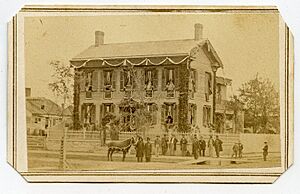
Abraham Lincoln came to the Springfield area in 1831. He moved into the city in 1837. He lived and worked there for 24 years as a lawyer and politician. Lincoln gave his famous Lyceum address in Springfield. His farewell speech when he left for Washington, D.C., is also very well known.
Springfield During the Civil War
Springfield was very important during the American Civil War. Illinois soldiers trained here, with Ulysses S. Grant leading some of the first groups. The city was a strong supporter of the Union. New businesses and railroads were built to help the war effort. The first official death of the war was a Springfield resident, Colonel Elmer E. Ellsworth.
Camp Butler, a training camp for soldiers, opened near Springfield in 1861. It also held Confederate prisoners of war. After the war ended in 1865, Springfield became a major railroad center. It was also important for government and farming. By 1900, coal mining was also a big industry.
20th Century Changes
The Dana–Thomas House is a famous building designed by Frank Lloyd Wright. It was built in 1902–03. Susan Lawrence Dana, who loved art, asked Wright to design a house that would fit with music. The house has many unique art glass designs and light fixtures. It was a new kind of building for its time, different from older Victorian styles. The house is now a museum and is open for tours.
In August 1908, there was a period of violence in Springfield. This event led to the creation of the National Association for the Advancement of Colored People (NAACP).
Springfield in the 21st Century
On March 12, 2006, two strong tornadoes hit the city. They injured 24 people and caused a lot of damage to buildings.
On February 10, 2007, Barack Obama announced he would run for president in Springfield. He stood on the grounds of the Old State Capitol State Historic Site. He also announced Joe Biden as his running mate there in 2008.
Geography and Climate
Springfield is located in the central part of Illinois. It is about 80 miles (129 km) northeast of St. Louis. The city sits on a flat plain.
Springfield's Landscape
The city is about 558 feet (170 meters) above sea level. Springfield covers about 65.76 square miles (170.32 sq km). Most of this is land, but about 6.28 square miles (16.27 sq km) is water. The area is mostly flat because of ancient glaciers.
Lake Springfield is a large human-made lake. It covers about 4,200 acres (17 sq km). The city's water and power company owns it. The lake was created in 1935 by building a dam on Lick Creek. It provides drinking water for Springfield. It also cools the power plant on the lake. Many people visit the lake each year for fun. There are also many homes and parks along its 57 miles (92 km) of shoreline.
Springfield's Weather
Springfield has a climate with four distinct seasons. Summers are hot and humid. Winters are cold and can be snowy. Thunderstorms are common in spring and summer. Springfield is also on the edge of Tornado Alley. This means tornadoes can happen.
For example, a tornado hit Springfield in 1957, and two F2 tornadoes struck in 2006. No one died in the 2006 storms. The city has improved its tornado warning systems since then.
| Climate data for Springfield, Illinois (Abraham Lincoln Capital Airport), 1991–2020 normals, extremes 1879–present | |||||||||||||
|---|---|---|---|---|---|---|---|---|---|---|---|---|---|
| Month | Jan | Feb | Mar | Apr | May | Jun | Jul | Aug | Sep | Oct | Nov | Dec | Year |
| Record high °F (°C) | 73 (23) |
80 (27) |
91 (33) |
90 (32) |
101 (38) |
104 (40) |
112 (44) |
108 (42) |
102 (39) |
93 (34) |
83 (28) |
74 (23) |
112 (44) |
| Mean maximum °F (°C) | 58.1 (14.5) |
63.8 (17.7) |
74.9 (23.8) |
83.5 (28.6) |
89.5 (31.9) |
93.8 (34.3) |
94.5 (34.7) |
94.4 (34.7) |
91.9 (33.3) |
85.8 (29.9) |
72.0 (22.2) |
62.3 (16.8) |
96.5 (35.8) |
| Mean daily maximum °F (°C) | 35.9 (2.2) |
41.1 (5.1) |
53.1 (11.7) |
65.6 (18.7) |
75.7 (24.3) |
84.0 (28.9) |
86.8 (30.4) |
85.4 (29.7) |
80.2 (26.8) |
67.4 (19.7) |
52.7 (11.5) |
40.7 (4.8) |
64.1 (17.8) |
| Daily mean °F (°C) | 27.9 (−2.3) |
32.4 (0.2) |
43.2 (6.2) |
54.4 (12.4) |
65.1 (18.4) |
73.7 (23.2) |
76.5 (24.7) |
74.9 (23.8) |
68.0 (20.0) |
56.0 (13.3) |
43.5 (6.4) |
32.9 (0.5) |
54.0 (12.2) |
| Mean daily minimum °F (°C) | 19.9 (−6.7) |
23.7 (−4.6) |
33.2 (0.7) |
43.3 (6.3) |
54.4 (12.4) |
63.3 (17.4) |
66.2 (19.0) |
64.3 (17.9) |
55.8 (13.2) |
44.6 (7.0) |
34.2 (1.2) |
25.2 (−3.8) |
44.0 (6.7) |
| Mean minimum °F (°C) | −4.2 (−20.1) |
2.4 (−16.4) |
12.6 (−10.8) |
27.3 (−2.6) |
38.1 (3.4) |
49.4 (9.7) |
54.5 (12.5) |
52.4 (11.3) |
39.6 (4.2) |
26.6 (−3.0) |
16.3 (−8.7) |
4.1 (−15.5) |
−8.4 (−22.4) |
| Record low °F (°C) | −22 (−30) |
−24 (−31) |
−12 (−24) |
16 (−9) |
28 (−2) |
39 (4) |
48 (9) |
43 (6) |
31 (−1) |
13 (−11) |
−3 (−19) |
−21 (−29) |
−24 (−31) |
| Average precipitation inches (mm) | 2.03 (52) |
1.93 (49) |
2.76 (70) |
3.97 (101) |
4.52 (115) |
4.61 (117) |
3.85 (98) |
3.37 (86) |
2.86 (73) |
3.26 (83) |
2.71 (69) |
2.15 (55) |
38.04 (966) |
| Average snowfall inches (cm) | 6.7 (17) |
6.1 (15) |
3.1 (7.9) |
0.3 (0.76) |
0.0 (0.0) |
0.0 (0.0) |
0.0 (0.0) |
0.0 (0.0) |
0.0 (0.0) |
0.1 (0.25) |
1.2 (3.0) |
4.3 (11) |
21.8 (55) |
| Average precipitation days (≥ 0.01 in) | 9.7 | 8.9 | 10.5 | 11.5 | 12.6 | 10.6 | 8.5 | 8.2 | 7.3 | 9.1 | 8.8 | 9.0 | 114.7 |
| Average snowy days (≥ 0.1 in) | 5.2 | 4.2 | 1.9 | 0.3 | 0.0 | 0.0 | 0.0 | 0.0 | 0.0 | 0.1 | 1.0 | 3.6 | 16.3 |
| Average relative humidity (%) | 73.4 | 74.0 | 71.3 | 65.3 | 65.6 | 66.6 | 70.4 | 74.0 | 71.9 | 68.4 | 73.8 | 77.6 | 71.0 |
| Mean monthly sunshine hours | 160.7 | 158.7 | 186.5 | 225.8 | 281.2 | 308.0 | 320.7 | 291.0 | 248.4 | 214.0 | 140.2 | 129.3 | 2,664.5 |
| Percent possible sunshine | 53 | 53 | 50 | 57 | 63 | 69 | 70 | 68 | 66 | 62 | 47 | 44 | 60 |
| Source: NOAA (sun and humidity 1961–1990) | |||||||||||||
City Layout and Neighborhoods
Springfield has a grid system for its streets. Numbered streets run north to south, starting with First Street. Major east-west streets include North and South Grand Avenues.
Springfield has many neighborhoods. Some of these include Downtown, Harvard Park, and Lincoln Park. The city also completely surrounds four smaller towns. These are Jerome, Leland Grove, Southern View, and Grandview.
Population and People
| Historical population | |||
|---|---|---|---|
| Census | Pop. | %± | |
| 1840 | 2,579 | — | |
| 1850 | 4,533 | 75.8% | |
| 1860 | 9,320 | 105.6% | |
| 1870 | 17,364 | 86.3% | |
| 1880 | 19,743 | 13.7% | |
| 1890 | 24,963 | 26.4% | |
| 1900 | 34,159 | 36.8% | |
| 1910 | 51,678 | 51.3% | |
| 1920 | 59,183 | 14.5% | |
| 1930 | 71,864 | 21.4% | |
| 1940 | 75,503 | 5.1% | |
| 1950 | 81,628 | 8.1% | |
| 1960 | 83,271 | 2.0% | |
| 1970 | 91,753 | 10.2% | |
| 1980 | 99,637 | 8.6% | |
| 1990 | 105,227 | 5.6% | |
| 2000 | 111,454 | 5.9% | |
| 2010 | 116,250 | 4.3% | |
| 2020 | 114,394 | −1.6% | |
| U.S. Decennial Census | |||
In 2020, Springfield had a population of 114,394 people. Most residents were White (67.99%). About 20.22% were Black or African American. Other groups included Asian (2.91%) and people of two or more races (5.15%). About 3.13% of the population was Hispanic or Latino.
In 2000, there were 48,621 households in the city. About 27.5% of these households had children under 18. The average household had 2.24 people. The median age in the city was 37 years old.
Springfield's Economy
Many jobs in Springfield are related to the state government. The State of Illinois is the largest employer in the city. It employs about 17,000 people. Healthcare and trade also provide many jobs.
Major Employers in Springfield
Here are some of the biggest employers in Springfield:
| No. | Employer | Employees |
|---|---|---|
| 1 | State of Illinois | 17,800 |
| 2 | Memorial Health System | 5,238 |
| 3 | Hospital Sisters Health System | 4,434 |
| 4 | Springfield Clinic | 2,449 |
| 5 | Springfield Public Schools | 2,130 |
| 6 | University of Illinois Springfield | 1,642 |
| 7 | Southern Illinois University School of Medicine | 1,470 |
| 8 | City of Springfield | 1,410 |
| 9 | Horace Mann Educators Corporation | 1,066 |
| 10 | BlueCross BlueShield | 900 |
Arts and Culture in Springfield
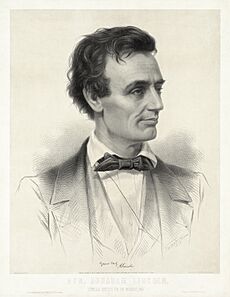
Springfield has been home to many famous people. Poet Vachel Lindsay was born here in 1879. Business leaders like John L. Lewis and Marjorie Merriweather Post also lived in Springfield. Astronomer Seth Barnes Nicholson was born here too.
A community of Portuguese immigrants settled in Springfield in 1849. They came from Madeira because they were Protestants in a mostly Catholic country.
Performing Arts and Entertainment
The Hoogland Center for the Arts is a main place for performing arts in downtown Springfield. It hosts groups like the Springfield Theatre Centre. The Springfield Municipal Opera, also called The Muni, puts on outdoor musicals in the summer. Sangamon Auditorium at the University of Illinois Springfield is a larger venue for shows.
Some movies have been filmed or had parts created in Springfield. For example, Legally Blonde 2: Red, White & Blonde was filmed here in 2003. Musicians Artie Matthews and Morris Day also lived in Springfield.
Festivals and Events
Springfield hosts the annual Springfield Old Capitol Art Fair in May. Since 2002, the city has also held the 'Route 66 Film Festival'. This festival celebrates movies related to the famous Route 66.
Fun Things to Do and See
Springfield is known for some unique foods. The corn dog might have been invented here, called a "Cozy Dog." The horseshoe sandwich, a local specialty, also started in Springfield. The city is also famous for its "chilli," spelled with two 'L's. In 1993, the Illinois state government even called Springfield the "Chilli Capital of the Civilized World."
Springfield has many places linked to U.S. President Abraham Lincoln. These include his home, the Lincoln-Herndon Law Offices State Historic Site, and the Lincoln Tomb State Historic Site. The Old State Capitol State Historic Site and the Abraham Lincoln Presidential Library and Museum are also popular. Lincoln's family church, First Presbyterian Church, still displays their original pew.
Near Springfield, you can visit New Salem State Park. This is a rebuilt village of log cabins where Lincoln lived when he was young.
The Donner Party, a group of pioneers who faced great hardship, started their journey West from Springfield. The Dana–Thomas House is a beautiful example of Frank Lloyd Wright's early "Prairie" style homes.
Washington Park is home to the Thomas Rees Memorial Carillon, a large musical instrument. A carillon festival is held there every year. In August, the city hosts the Illinois State Fair at the Illinois State Fairgrounds.
Abraham Lincoln lived in Springfield for 24 years. His only home is open to the public for free.
Springfield also has a large amusement park called Knight's Action Park and Caribbean Water Park. It is open from May to September. The park also has the city's only remaining drive-in theater.
Sports in Springfield
| team | League | Sport | Venue | Established | Championships |
|---|---|---|---|---|---|
| Springfield A.S.C | USL League Two | Association football | Sacred Heart-Griffin High School | 2021 | 0 |
| Springfield FC | Midwest Premier League | Association football | SASA Soccer Complex | 2011 | 0 |
| Springfield Lucky Horseshoes | Prospect League | Baseball | Robin Roberts Stadium | 2008 | 1 |
| Springfield Jr. Blues | North American Hockey League | Ice Hockey | Nelson Center | 1993 | 2 |
| Capital City Hooligans | Men's Roller Derby Association | Men's Roller Derby | Skateland South | 2012 | N/A |
Springfield has been home to several minor league baseball teams. Today, the city has the Springfield Jr. Blues, a hockey team that plays at the Nelson Recreation Center.
Many professional athletes come from Springfield. These include Major League Baseball players like Kevin Seitzer and Robin Roberts. Springfield's largest baseball field is named after Robin Roberts. National Basketball Association players Dave Robisch and Andre Iguodala are also from Springfield. In 2016, Springfield native Ryan Held won a gold medal in swimming at the Olympics.
Parks and Recreation Areas
The Springfield Park District manages over 30 parks. Two well-known parks are Carpenter Park and Washington Park. Washington Park has the Thomas Rees Memorial Carillon. Southwind Park is designed to be fully accessible for people with disabilities. Lincoln Park has the Nelson Recreation Center with a swimming pool and ice rink.
Springfield also has two private tree gardens: the Abraham Lincoln Memorial Garden and the Adams Wildlife Sanctuary.
Education in Springfield
Springfield has six public and private high schools. The public schools are part of District No. 186. This district runs 24 elementary schools and three high schools. These high schools are Lanphier High School, Springfield High School, and Springfield Southeast High School.
Sacred Heart-Griffin High School is a Catholic high school in the city. Other high schools include Calvary Academy and Lutheran High School.
Springfield is home to the University of Illinois Springfield (UIS). It also has a junior college called Lincoln Land Community College. The Springfield campus of the Southern Illinois University School of Medicine is also located here.
Media and News
The State Journal-Register is Springfield's main daily newspaper. It started in 1831 and is one of the oldest newspapers in Illinois. The local alternative weekly newspaper is the Illinois Times.
Television and Radio
Springfield is part of a larger TV market. Four TV stations broadcast from the Springfield area: WCIX, WICS, WRSP, and WSEC. Many radio stations also broadcast in the Springfield area.
City Services and Transportation
The city's power and water company, City Water, Light & Power, provides electricity and water from Lake Springfield.
Getting Around Springfield
Interstate 55 runs north to south past Springfield. I-72 runs east to west.
Amtrak trains serve Springfield daily. The Lincoln Service runs between Chicago and St. Louis. The Texas Eagle travels between San Antonio and Chicago. Freight trains also use Springfield's railways. Greyhound buses also serve the city.
The Sangamon Mass Transit District (SMTD) operates the city's bus system. Springfield is also located along historic Route 66.
The Abraham Lincoln Capital Airport offers flights to Chicago O'Hare and other cities. Springfield also has many bike trails and bike lanes. These include the Interurban Trail and the Lost Bridge Trail.
Notable People from Springfield
Sister Cities
Springfield, Illinois, has two sister cities:
It also has a "Friendship" city connection with Killarney, Ireland.
See also
 In Spanish: Springfield (Illinois) para niños
In Spanish: Springfield (Illinois) para niños


